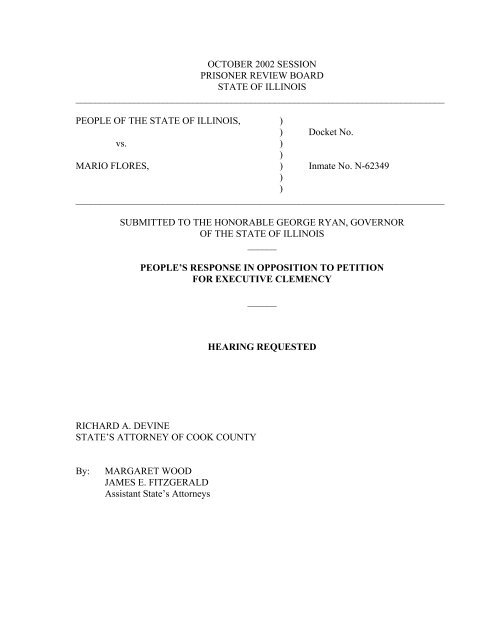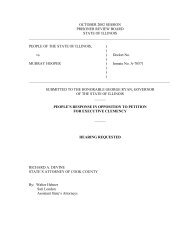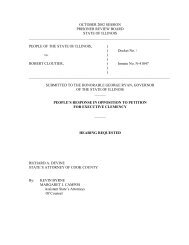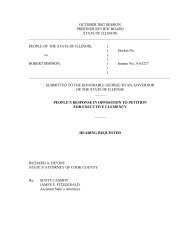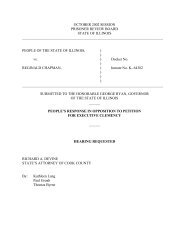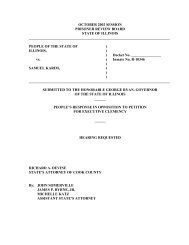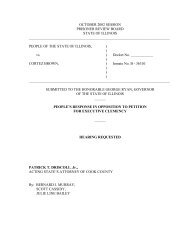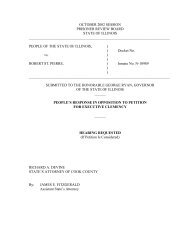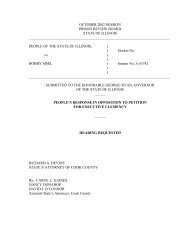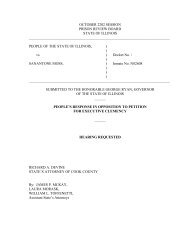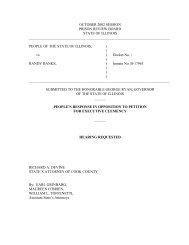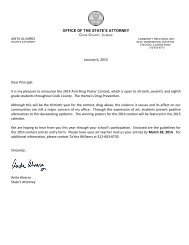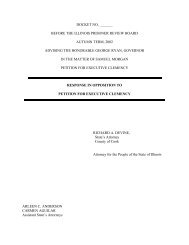Mario Flores - Cook County State's Attorney
Mario Flores - Cook County State's Attorney
Mario Flores - Cook County State's Attorney
Create successful ePaper yourself
Turn your PDF publications into a flip-book with our unique Google optimized e-Paper software.
OCTOBER 2002 SESSION<br />
PRISONER REVIEW BOARD<br />
STATE OF ILLINOIS<br />
____________________________________________________________________________<br />
PEOPLE OF THE STATE OF ILLINOIS, )<br />
) Docket No.<br />
vs. )<br />
)<br />
MARIO FLORES, ) Inmate No. N-62349<br />
)<br />
)<br />
____________________________________________________________________________<br />
SUBMITTED TO THE HONORABLE GEORGE RYAN, GOVERNOR<br />
OF THE STATE OF ILLINOIS<br />
______<br />
PEOPLE’S RESPONSE IN OPPOSITION TO PETITION<br />
FOR EXECUTIVE CLEMENCY<br />
______<br />
HEARING REQUESTED<br />
RICHARD A. DEVINE<br />
STATE’S ATTORNEY OF COOK COUNTY<br />
By:<br />
MARGARET WOOD<br />
JAMES E. FITZGERALD<br />
Assistant State’s <strong>Attorney</strong>s
OCTOBER 2002 SESSION<br />
PRISONER REVIEW BOARD<br />
STATE OF ILLINOIS<br />
____________________________________________________________________________<br />
PEOPLE OF THE STATE OF ILLINOIS, )<br />
) Docket No.<br />
vs. )<br />
)<br />
MARIO FLORES, ) Inmate No. N-62349<br />
)<br />
)<br />
____________________________________________________________________________<br />
I<br />
HISTORY OF THE CASE<br />
The defendant was convicted of murder and armed robbery in the Circuit Court of <strong>Cook</strong><br />
<strong>County</strong>. The same jury found that defendant was eligible for the death penalty because defendant<br />
had actually killed the victim, Gilbert Perez, and the victim’s death had occurred during the course<br />
of an armed robbery. The jury then returned a death sentence. Defendant’s convictions and<br />
sentence of death, as well as the denial of his first post-conviction petition, were affirmed on direct<br />
appeal. People v. <strong>Flores</strong>, 128 Ill. 2d 66 (1989). The denial of defendant’s successive petition for<br />
post-conviction relief was also affirmed. People v. <strong>Flores</strong>, 153 Ill. 2d 66 (1992). Defendant’s<br />
federal habeas corpus petition is pending in United States District Court.<br />
1
II<br />
FACTS OF THE CASE<br />
Defendant, <strong>Mario</strong> <strong>Flores</strong>, was indicted for murder, armed robbery, and armed violence;<br />
all charges arising out of the January 1, 1984, shotgun murder of Gilbert Perez. (R. 706-711) At the<br />
conclusion of a jury trial in the Circuit Court of <strong>Cook</strong> <strong>County</strong>, defendant was found guilty of<br />
murder and of armed robbery. (R. 541-542) Following a sentencing hearing held before the same<br />
jury, <strong>Flores</strong> was sentenced to death for the murder of Gilbert Perez. (R. 678-682)<br />
Gilbert Perez met his death as the result of multiple shotgun wounds inflicted upon him<br />
during the early morning hours of January 1, 1984. The basic question presented to the jury as trier<br />
of fact here was whether the defendant was the person who had inflicted those fatal wounds.<br />
Anna Rodriguez was the mother of the victim, Gilbert Perez. (R. 209-210) She last saw<br />
him alive shortly after midnight on January 1, 1984, when he left her home. (R. 210-211) When<br />
she next saw her son, in a hospital, he was dead. (R. 211)<br />
On the morning of January 1, 1984, Willie Collins was driving from his home to a<br />
church at Van Buren and Sacramento in Chicago. (R. 212-213) As he made a right turn onto St.<br />
Paul Street, the headlights of his automobile illuminated the body of a man lying in the snow on St.<br />
Paul Street. (R. 213-214) He saw a police officer who appeared to be investigating an accident on<br />
Western Avenue, drove to Western, and told the officer what he had seen. (R.214-215)<br />
The policeman summoned by Mr. Collins was Patrolman Herbert Matthews. (R. 215-<br />
216) At approximately 6:50 a.m. on January 1, 1984, he was investigating an accident on Western<br />
Avenue when Mr. Collins approached him. (R. 215-217) He went to the scene and observed the<br />
body of a man lying near the mouth of an alley on St. Paul Street. (R. 217) He observed that the<br />
2
man had been shot, and called other officers to the scene to investigate. (R. 217) He observed spent<br />
shotgun shells on the ground near the body, but did not know how many shells were lying in the<br />
snow. (R. 218)<br />
Detective Lawrence Poll, a Chicago Police Officer assigned to Area Five Violent<br />
Crimes, arrived on the shooting scene at about 7:00 a.m. (R. 222-224) He observed the body of the<br />
victim lying near the mouth of an alley at 2259 North St. Paul Street. (R. 224) The body was lying<br />
on its left side, face down in the snow. There were pools of blood around the body itself, and blood<br />
spattered on a nearby wall. (R. 225) Five spent shotgun shells were recovered from the area of the<br />
victim's body by crime laboratory personnel. (R. 225) The area was industrial, with no private<br />
dwellings but only warehouses in the area. (R. 225-226) The weather was cold and the victim's<br />
face and the left side of his body were frozen to the ground. (R. 225, 232-233) The witness<br />
subsequently learned that the victim was Gilbert Perez (R. 229), and that he was a member of the<br />
Latin Stylers street gang. (R. 231-232)<br />
Nineteen year old Victor <strong>Flores</strong>, who was not related to the defendant but who had<br />
known him for about three years (R. 349-350), testified concerning what took place on the morning<br />
of January 1, 1984. He testified that both he and <strong>Mario</strong> <strong>Flores</strong> were members of the Latin Brothers<br />
street gang. (R. 350-351) Shortly after midnight on January 1, 1984, defendant telephoned the<br />
witness and asked if he wanted to go out. (R. 351) The witness told defendant he would have to get<br />
back to him but, when defendant called back and said he would pick Victor up, Victor agreed to<br />
go. (R.351-352) The defendant picked the witness up driving defendant's sister's automobile, a<br />
burgundy, 1982 Buick Regal. (R. 352) They decided to go downtown and to that end drove east on<br />
North Avenue. However, weather conditions became worse and, at a point between Damen and<br />
3
Ashland Avenues, they turned back. (R.352-353) As defendant drove west on North Avenue,<br />
another automobile passed them at a high rate of speed, forcing them to move to the side to get out<br />
of the way. (R. 353) They saw this same automobile again at the intersection of North and Western<br />
Avenues, where it had become involved in an accident with another vehicle. Defendant pulled the<br />
car he was driving to the side of the road. At that juncture, another automobile arrived and stopped<br />
beside them; this automobile being driven by Harry Gomez. (R. 354-355) Gomez and defendant<br />
discussed how each of them had almost been struck by the automobile involved in the accident at<br />
the intersection.<br />
Gomez, defendant and the witness then got out of their respective automobiles. (R. 356-<br />
357) The man involved in the accident was the victim, Gilbert Perez. (R. 356) Defendant and<br />
Gomez started toward the victim, who was standing in the intersection with the woman whose car<br />
Perez had struck. (R.356) The victim was threatening the woman, and when defendant and Gomez<br />
approached, he threatened them also, although he had no weapon. (R. 357-358) The victim made a<br />
pitchfork sign, indicating membership in a street gang known as the Latin Stylers. (R. 358) This<br />
gang is one of a group of gangs known as "Folks." (R. 358-359) The Latin Brothers, to which<br />
defendant and the witness belong, is a gang related to another group known as "People." (R. 359)<br />
At this juncture, defendant returned to the automobile he was driving and took a shotgun from the<br />
trunk. (R. 359) The witness described this weapon as a sawed-off, single barreled, 12 gauge<br />
shotgun with a pump action. (R. 359-360) Harry Gomez said something to the defendant, then went<br />
back to the victim and put an arm around his shoulder. (R. 359-360) Gomez brought the victim to<br />
defendant's automobile and told the witness to slide over into the driver's seat. The victim then got<br />
into the front passenger seat, while defendant sat in the back seat with the shotgun still in his<br />
4
possession. Gomez returned to his own automobile, and defendant instructed Victor <strong>Flores</strong> to drive<br />
and to follow Gomez. (R.360-361) Defendant told the victim that Harry was "Mousey" from the<br />
"Ds," a gang associated with the "Folks," as was the victim. In reality, defendant and the witness<br />
were members of the Latin Brothers, "People," and rivals of the "Folks." (R. 362)<br />
The two automobiles drove on Western Avenue to St. Paul Street, turned right, and<br />
drove half a block; stopping in a factory area. (R.362) Harry Gomez got out of his automobile, as<br />
did defendant and the victim. (R. 363) At this time, defendant was holding the shotgun he had<br />
earlier taken from the trunk of the burgundy automobile. (R. 363) Defendant took the victim<br />
toward Gomez at which time the witness began to turn the car around. (R. 363-364) As he was<br />
doing this, Victor <strong>Flores</strong> heard "four or more" shots fired. (R. 364) He looked in the rear-view<br />
mirror and saw defendant holding the shotgun, the victim lying on the ground, and Gomez bending<br />
over the victim. (R. 364) The witness drove off at a high rate of speed. (R. 355) Defendant and<br />
Gomez, in Gomez's car, caught up with him on Western Avenue and directed him to drive to<br />
Gomez's house. (R. 365-366) There, defendant told him not to worry about what had happened on<br />
St. Paul Street. (R. 368)<br />
Gomez was holding a handfull of chains which had been taken from the victim. (R. 367-<br />
368) Defendant then drove the witness home. (R. 368-369) On November 10, 1984, the witnesses<br />
and defendant were arrested as they parked the burgundy automobile behind defendant's house. (R.<br />
369) Victor <strong>Flores</strong> subsequently gave a statement to an Assistant <strong>State's</strong> <strong>Attorney</strong> at the police<br />
station. (R. 370-371) The witness was arrested in connection with the instant murder. (R. 374)<br />
On cross-examination the witness stated that he had made no "deal" with the<br />
prosecution, but that he was hoping for consideration in return for his truthful testimony at<br />
5
defendant's trial. (R. 374-395) He further stated that the prosecutors had told him to tell the truth<br />
(R. 399), and that he was hoping that by doing so he might help himself as to the charges against<br />
him. (R. 400-401)<br />
The beginning of events leading to the death of the victim was witnessed by Nancy<br />
Lebron. (R. 273) On the morning of the murder, she lived in a second floor apartment overlooking<br />
the intersection of North and Western Avenue in Chicago. (R.273-274) At about two a.m., she was<br />
awakened by the sound of an automobile accident in the intersection. (R. 274-275) From her<br />
window she saw one of the cars involved stopped near the electrical pole. As she watched, a<br />
"wine" colored automobile arrived on the scene. (R. 275-276) Shortly, another automobile arrived<br />
from a different direction. (R. 276) At this juncture she saw the victim, Gilbert Perez, get out of the<br />
automobile near the electrical pole. (R. 276-277) She then saw men getting out of the cars which<br />
had just arrived on the scene. She saw defendant, <strong>Mario</strong> <strong>Flores</strong>, go to the trunk of the wine colored<br />
car and remove a shotgun, which he pointed in the direction of the victim. (R. 277-278) One of<br />
defendant's companions then said something to him, and defendant put the shotgun into the rear<br />
seat of the wine colored car. (R. 278-279) The victim was eventually led to the wine colored<br />
automobile, where he sat in the front passenger seat. (R. 279) Another person got into the driver's<br />
seat and defendant got into the rear seat where he had previously placed the shotgun. (R. 279) The<br />
witness wrote down the license number of the wine colored automobile. (R. 279-280) As other<br />
evidence in the case shows, one digit of the number was left out when it was passed on to police.<br />
The two automobiles then drove off. (R. 280) Her husband telephoned police with the license<br />
number, but did not leave his name. (R. 280) A few days later she learned that the victim had been<br />
murdered. (R. 280)<br />
6
Shortly thereafter, she was contacted by Officer Guevara of the Chicago Police<br />
Department. (R. 281) She testified that she told him that she did not wish to get involved since she<br />
feared for the safety of her children. (R. 281-282) However, in November, 1984, she contacted the<br />
officer and told him what she had seen. (R. 282) On November 9, 1984, she looked through six<br />
books of photographs at the police station and identified photographs of <strong>Mario</strong> <strong>Flores</strong> and Sammy<br />
Ramos. (R. 282-283) On the following day, November 10th, she viewed a lineup in which she<br />
identified <strong>Mario</strong> <strong>Flores</strong> as the man with the shotgun and Victor <strong>Flores</strong> as the driver of the wine<br />
colored car. (R. 283-284) She also stated that on the night of the murder, <strong>Mario</strong> <strong>Flores</strong> had been<br />
wearing a green jacket. (R. 287)<br />
On cross-examination, Ms. Lebron stated that she had decided to go to the police since<br />
people were coming to her home threatening her children. (R. 292-294) When she told the police<br />
what she knew, those visits stopped.<br />
Detective Jerome Bogucki conducted a six man lineup on November 10, 1984, for<br />
Nancy Lebron. (R. 300) There she identified <strong>Mario</strong> <strong>Flores</strong> and Victor <strong>Flores</strong>. (R. 300-302) Sammy<br />
Ramos was also in the lineup, but Ms. Lebron did not identify him as involved in this crime. (R.<br />
302) She also identified a maroon automobile parked in front of the police station bearing the<br />
license number AA 9559. (R. 303) She also identified a green jacket as resembling one warn by<br />
defendant on the night of the murder. (R. 303-304)<br />
Rinaldo Guevara was a gang crimes specialist with the Chicago Police Department. (R.<br />
237-238) On the day following the murder, he became involved in the investigation when he<br />
received an anonymous telephone call about the killing. (R. 238-239) As a result of that call he<br />
sought out Nancy Lebron who he knew. (R. 239-241) Several days later he met Ms. Lebron and<br />
7
her daughter on the street and spoke to them about the murder of Gilbert Perez. (R. 241) Following<br />
this, a second anonymous telephone call was received concerning the license number of an<br />
automobile seen at North and Western Avenues on the night of the murder. (R. 241-242) The<br />
number, as he received it, was AA 959. Investigation of the automobile bearing these plates<br />
showed it not to fit the description they had of the automobile involved in the murder. The<br />
description which police had was of a 1982 Buick Regal, maroon in color, with "smoked"<br />
windows. (R. 242-243)<br />
On November 9, 1984, he received a telephone call from Nancy Lebron and<br />
subsequently met with her in his office. (R. 243-245) She stated that she could identify the men<br />
involved in the incident at Western and North Avenues. She looked through six books of<br />
photographs, definitely identifying <strong>Mario</strong> <strong>Flores</strong> and tentatively identifying Sammy Ramos. (R.<br />
245-246) Sammy Ramos was located and brought into the police station. (R. 246) After a<br />
conversation with him, it was determined that the actual license number of the wine or maroon<br />
automobile involved was AA 9559, an automobile registered to Lena <strong>Flores</strong>, sister of the<br />
defendant. (R. 246-247)<br />
On the following day, November 10th, <strong>Mario</strong> <strong>Flores</strong> and Victor <strong>Flores</strong> were arrested<br />
while driving this automobile. (R. 248-249) Subsequently, pursuant to a search warrant, a green<br />
jacket was obtained from the <strong>Flores</strong> residence. (R. 249-250)<br />
Sammy Ramos was called as a witness by the People after having been granted<br />
immunity. (R. 317-319) He stated that he knew <strong>Mario</strong> <strong>Flores</strong> and that both he and defendant were<br />
members of the Latin Brothers. (R. 321, 342) He stated that he did not recall a conversation with<br />
<strong>Mario</strong> <strong>Flores</strong> in January, 1984 (R. 321-322), and that although he did remember being arrested in<br />
8
connection with this offense and taken before the Grand Jury, he did not recall his testimony there.<br />
(R. 322-323) After reading over the Grand Jury transcript, the witness stated that it did contain the<br />
content of a conversation had between himself and defendant on January 7, 1984. (R. 323-324)<br />
However, the witness insisted that he did not independently recall what he said before the Grand<br />
Jury. He did recall that the conversation took place right in front of his house. (R. 325)<br />
The Grand Jury testimony was then gone over with the witness. It indicated that Ramos<br />
had a conversation with defendant in which defendant described the incident in which he, Victor<br />
<strong>Flores</strong> and Harry Gomez came upon the victim at the scene of an accident; that they told the victim<br />
that they were "Folks" and he accompanied them in their car; and that defendant shot the victim<br />
with a shotgun on St. Paul Street. (R. 325-331) The witness was also told that jewelry was taken<br />
from the victim.<br />
Ramos further testified at trial that he did not believe any of what defendant told him<br />
since defendant would not have done anything like that. (R. 340-341, 344-345)<br />
Assistant <strong>State's</strong> <strong>Attorney</strong> Jack Quirk testified that he questioned Sammy Ramos before<br />
the Grand Jury on November 13, 1984, and that the transcript accurately reflected the testimony<br />
given by Ramos at that time. (R. 346-347) It was stipulated that the cause of death of the victim<br />
was multiple shotgun wounds, involving massive injuries to the head, chest, and internal organs.<br />
(R. 410-414) It was further stipulated that Lina <strong>Flores</strong>, sister of the defendant, was the owner of the<br />
wine or maroon automobile involved in the murder. (R. 414) Thirdly, it was stipulated that<br />
defendant was twenty years of age at the time of the instant trial. (R. 414)<br />
Vincent Lamora, was a Chicago Police Department firearm expert. (R. 438- 439) He<br />
testified that on January 3, 1984, he examined a number of shotgun pellets received from the<br />
9
medical examiner in connection with the murder of Gilbert Perez. (R. 439-440) Subsequently, he<br />
examined five spent 12 gauge shotgun shells in connection with this case. He was able to definitely<br />
determine that three of these had been fired from the same shotgun, but could not make a definate<br />
determination as to the other two shells. (R. 442- 443) The nature of the weapon involved appeared<br />
to be a pump action or auto-load 12 gauge shotgun. (R. 444-446) All five shells could have been<br />
fired from the same shotgun; reduced pressure in the shells can cause them not to "slam" back<br />
against the breach face as hard as others so that the same markings would not be left on them. (R.<br />
446-447) All five shells bore similar firing pin markings. (R. 447)<br />
Following closing arguments and instructions to the jury, the jury returned verdicts<br />
finding defendant guilty of murder and of armed robbery. (R. 541-543)<br />
At the first phase of the subsequent sentencing hearing before the same jury, Officer<br />
Renaldo Guevara testified that on November 10, 1984, subsequent to <strong>Mario</strong> <strong>Flores</strong>' arrest, he spoke<br />
to <strong>Flores</strong> in the police station. (R. 559-560) Defendant told him that his date of birth was July 26,<br />
1965, which meant that on January 1, 1984, defendant had already passed his eighteenth birthday.<br />
(R. 560)<br />
Larry Zadlo testified that he was an employee of the <strong>Cook</strong> <strong>County</strong> Clerk, that he was<br />
present in the courtroom when the jury returned the guilty verdicts in the instant case, and that<br />
judgment had been entered on those verdicts. (R. 561-562)<br />
Following closing arguments and jury instructions at this first phase of the sentencing<br />
hearing, the jury returned a verdict finding defendant eligible to receive the penalty of death. (R.<br />
572-573)<br />
10
At the second phase of the sentencing hearing, it was stipulated that defendant, as a<br />
juvenile, had been adjudged guilty of criminal trespass to a vehicle, retail theft, and on two<br />
occasions of possession of a stolen. motor vehicle. (R. 582-583) Each of these adjudications had<br />
resulted in defendant being placed on probation.<br />
Officer Renaldo Guevara testified that he had been acquainted with defendant for five<br />
years and that <strong>Mario</strong> <strong>Flores</strong> was an active, hard-core member of the gang known as the Latin<br />
Brothers. (R. 583-585)<br />
Chicago Police Officer Roger Hodge testified that on November 22, 1983, the police had<br />
under surveillance a garage housing stolen automobiles. (R. 588-589) At about 9:30 that evening,<br />
he saw the defendant. (R. 588) A black automobile pulled up to the garage, its passenger began to<br />
flee on foot, and defendant, who was driving, got out and began to walk away. (R. 589-590) The<br />
witness caught up with defendant and placed a hand on his shoulder. When another officer shouted<br />
that the black automobile was stolen, defendant ran and the witness lost him. (R.590-591) Since the<br />
officer remembered seeing defendant somewhere before, he checked his files and was able to<br />
identify the person as <strong>Mario</strong> <strong>Flores</strong>. (R. 591) He went to defendant's home, and then to a high<br />
school where he found out that defendant had been suspended. (R. 591-592) This same witness<br />
arrested defendant again in 1984, in connection with the shooting of Louis Rosero. (R. 592)<br />
Louis Rosero testified that he was 25 years of age. (R. 594) On August 5, 1984, at about<br />
12:30 a.m., he was driving in the area of Lockwood and North Avenues when he was stopped by<br />
the defendant. (R. 595) <strong>Flores</strong> told the witness that he was going to give him some tires in lieu of<br />
the money which he owed him, and told him to drive to a particular alley. (R. 596-597) Defendant<br />
instructed him to wait while defendant opened the garage. When defendant returned without<br />
11
opening the garage, the witness got out of his automobile. (R. 597-598) The defendant was now<br />
holding a .38 caliber pistol and opened fire on Rosero. Rosero was struck five times in the chest,<br />
and by two other bullets in the back, these severing his spinal cord. (R. 598) The witness now has<br />
sections of artificial intestines in his body, and a colostomy bag. (R. 598-599) He will never walk<br />
again. (R. 599) As a result of this shooting, the witness spent six months in the hospital and<br />
underwent a number of surgeries. (R. 600-601) He still must visit his doctor every two weeks. Mr.<br />
Rosero testified that while firing the shots at him, defendant was smiling. (R. 599)<br />
12
III<br />
REASONS FOR DENYING THE PETITION<br />
The facts of this case alone are sufficient to deny defendant’s request for clemency. The<br />
defendant and his cohorts lured Gilbert Perez into a false sense of security by telling him that they<br />
all belonged to the same nation of gangs. After gaining Gilbert Perez’s trust they took him from<br />
the scene of his car accident and drove away. While in the car they reassured him of their good<br />
intentions. However, they drove to an industrial area during those early morning hours of New<br />
Year’s Day, got him out of the car and then defendant used a shot gun to kill him. The attack was<br />
so vicious that the shotgun wounds resulted in massive injuries to Gilbert’s head, chest and internal<br />
organs. Indeed, a portion of Gilbert’s head was blown away as a result of defendant’s attack.<br />
When the body was found it was frozen to ground, and when Gilbert’s body was rolled over his<br />
intestines flowed onto the ground. Given the brutal, heinous and vicious nature of the crime it is<br />
clear that defendant does not deserve clemency.<br />
Defendant presents one overriding reason in support of his plea for clemency, that he<br />
was found eligible for the death penalty pursuant to a flawed factor – the death occurred during the<br />
course of an armed robbery. This claim was emphatically rejected by our Supreme Court when it<br />
held,<br />
13
The defendant also contends there was error in his<br />
sentencing proceeding. The defendant's first argument is<br />
that since the armed robbery conviction is not before this<br />
court for review, and the armed robbery served as the<br />
predicate making him subject to the death penalty under<br />
section 9 -- l(b)(6) of the Criminal Code (Ill. Rev. Stat.<br />
1985, ch. 38, par. 9 -- l(b)(6)), the death sentence must be<br />
vacated. We disagree.<br />
Section 9 -- 1 (b)(6) provides:<br />
"A defendant * * * who has been found guilty of murder<br />
may be sentenced to death if:<br />
* * *<br />
6. the murdered individual was killed in the course of<br />
another felony if:<br />
(a) the murdered individual:<br />
(i) was actually killed by the defendant * * *<br />
* * * and<br />
(b) in performing the acts which caused the death of the<br />
murdered individual * * * the defendant acted with the<br />
intent to kill the murdered individual or with the<br />
knowledge that his acts created a strong probability of<br />
death or great bodily harm to the murdered individual or<br />
another; and<br />
(c) the other felony was one of the following: * * * armed<br />
robbery * * *." Ill. Rev. Stat. 1985, ch. 38, par. 9-1 (b)(6).<br />
The defendant's argument fails to consider that it is the<br />
evidence at trial and at sentencing establishing that the<br />
murder was committed in the course of an armed robbery<br />
that subjects the defendant to the death penalty under<br />
section 9 -- l(b)(6), and not the conviction itself. Indeed,<br />
the armed robbery need not have been completed to make<br />
the defendant subject to the death penalty under the<br />
statute. See People v. Ramirez (1983), 98 Ill. 2d 439, 458.<br />
The defendant also contends that the evidence was<br />
14
insufficient to subject him to the death penalty under<br />
section 9 -- l(b)(6) in that it did not show that the victim<br />
was murdered in the course of armed robbery. The<br />
defendant says because the record shows that the victim<br />
was killed instantly from a shotgun blast and that the<br />
victim's possessions were taken thereafter, that no "force"<br />
was involved in taking the victim's possessions. He argues<br />
also that there is nothing in the record suggesting an intent<br />
to rob the victim before he was killed. The defendant says<br />
the intent to rob was simply an unrelated afterthought.<br />
It is true that armed robbery is the taking of property<br />
from the person or presence of another by the use of force<br />
or by threatening the imminent use of force while armed<br />
with a dangerous weapon. (Ill. Rev. Stat. 1985, . ch. 38,<br />
par. 18 -- 2.) It is of no significance here, however, that the<br />
armed robbery did not commence prior to the fatal<br />
gunshots to subject the defendant to the death penalty<br />
under section 9 -- l(b)(6). As this court stated in People v.<br />
Richardson (1988), 123 Ill. 2d 322,359:<br />
"Just as the phrase 'in the course of does’ not require<br />
that defendant complete one of the other felonies in order<br />
to be eligible for the death sentence [citation], we also<br />
believe that it does not require that the armed robbery<br />
commence prior to the fatal gunshot, since the precise<br />
timing of the offenses is not necessarily indicative of<br />
defendant's intent. The jury concluded , beyond a<br />
reasonable doubt that defendant committed both a murder<br />
and an armed robbery, which offenses occurred essentially<br />
simultaneously. The trial testimony and verdicts<br />
sufficiently support the court's finding that the murder<br />
occurred 'in the course of an armed robbery.’”<br />
People v. <strong>Flores</strong>, 128 Ill. 2d at 97-98. The Supreme Court’s ruling is not seriously challenged by<br />
defendant, as he is merely seeking to have another forum weigh the evidence. The evidence that<br />
defendant actually killed Gilbert and that when he performed the acts which killed Gilbert the<br />
defendant acted with the intent to kill him was overwhelming. As the Supreme Court said “...from<br />
the record it can be seen that the evidence was not complicated...” Id. at 94. Defendant also<br />
asserts that he did not commit the robbery, that that was done by this cohort. The jury found<br />
15
defendant guilty of armed robbery. The question of who did the actual taking is of no moment<br />
because defendant was present at the time and held and fired the gun which resulted in Gilbert’s<br />
death. Defendant did nothing to disassociate himself from these crimes, rather he was the lead<br />
actor in the chain of events which culminated in Gilbert’s death.<br />
Defendant also claims that since he has been a model prisoner and become an artist since<br />
his incarceration he should be granted clemency. Being a model prisoner means one thing only<br />
and that is that defendant functions well in a controlled environment. Defendant’s criminal history<br />
tells more of his true character. Defendant had previously shot an individual numerous times<br />
leaving him paralyzed for life. The victim said that defendant was smiling as he shot him.<br />
Defendant was a young man when he committed this murder, that is why his criminal history is not<br />
more lengthy. But make no mistake about it, this defendant took advantage of his time as a free<br />
man and started his criminal career at an early age. That career escalated in seriousness as he got<br />
older and progressed to the point where he committed a brutal, heinous and vicious murder.<br />
Defendant also relies on an affidavit by an “expert” in an attempt to demonstrate alleged<br />
flaws in the investigation and trial of his case. The People submit that our Supreme Court is a<br />
better judge of the facts of this case and a better interpreter of the law applied to the case than is<br />
defendant’s “expert”. The Illinois Supreme Court has twice reviewed this case and in each<br />
instance has found that defendant’s right to a fair trial was observed.<br />
Defendant asserts that he is entitled to clemency because he did not receive the benefit<br />
of the changes to the Illinois capital sentencing system which have recently been adopted,<br />
proposed or enacted. By relying upon a laundry list of new Supreme Court Rules, statutes and<br />
proposals from the Governor’s Commission on Capital Punishment which were not available at the<br />
16
time of his trial, defendant claims that his trial (as well as that of every other capital defendant in<br />
Illinois) was by definition fundamentally unfair. However, the Illinois Supreme Court has<br />
expressly rejected the claim “that every capital trial has been unreliable and that all appellate<br />
review has been haphazard” (People v. Hickey, ___ Ill. 2d ___, 2001 Ill. LEXIS 1080 at *57 (No.<br />
87286 September 27, 2001)). Rather, the Court held that the additional safeguards included in its<br />
rules governing capital cases are not retroactively applicable because they “function solely as<br />
devices to further protect those rights given to defendants by the federal and state constitutions”<br />
and that “[a] violation of procedures designed to secure constitutional rights should not be equated<br />
with a denial of those constitutional rights.” Id. at *63, 64.<br />
Thus, the fact that the Court, the General Assembly and the Governor’s Commission<br />
have endeavored to improve the process does not mean that an injustice would result simply<br />
because the recent changes were not applied retroactively to defendant’s case. Instead, a true<br />
injustice would only result if it were reflexively determined that defendant’s trial was<br />
fundamentally unfair without any examination of the proceedings themselves. It is telling,<br />
however, that defendant has not even attempted to demonstrate how the recent changes would have<br />
affected the outcome of the proceedings. Moreover, defendant ignores the fact that every court<br />
which has examined the proceedings in his case determined that they were fundamentally fair and<br />
that he was not unduly prejudiced in any manner. Although defendant cites to no specific rule,<br />
statute or proposal in support of his petition, the People feel the following may apply to his<br />
petition.<br />
Supreme Court Rules<br />
17
Defendant asserts that he is entitled to clemency because the new Supreme Court Rules<br />
governing capital cases were not applicable to his proceedings. However, the Illinois Supreme<br />
Court has clearly held that the amendments to its rules are not retroactively applicable. Hickey,<br />
2001 Ill. LEXIS 1080 at *65.<br />
Adequate Funding<br />
Defendant asserts that he is entitled to clemency because he was denied adequate<br />
funding to investigate the case and/or to retain the necessary expert witnesses. However, despite<br />
the creation of the Capital Litigation Trust Fund, there is no indication that any capital defendant in<br />
Illinois, particularly those prosecuted in <strong>Cook</strong> <strong>County</strong> has ever been deprived of the necessary<br />
funds to investigate or retain appropriate experts. Rather, courts have denied various requests<br />
which are deemed unreasonable or unnecessary, the same standard which applies for funds under<br />
the Capital Litigation Trust Fund. 725 ILCS 124/15(c). Also, the <strong>Cook</strong> <strong>County</strong> Public Defender<br />
has significant resources available for capital litigation. Therefore, the mere fact that the Capital<br />
Litigation Trust Fund was not created until 2000 is irrelevant.<br />
Eligibility Factors<br />
Defendant asserts that he is entitled to clemency because he was found eligible for the<br />
death penalty based upon an aggravating factor other than those factors which the Governor’s<br />
Commission has recommended be retained. Specifically, the Commission concluded that the<br />
current list of 20 factors is overly expansive and therefore unconstitutional. Accordingly, it was<br />
suggested that the list be reduced to just five factors: (1) murder of a peace officer or fireman; (2)<br />
murder of any person in any correctional facility; (3) multiple murder; (4) murder accompanied by<br />
18
the intentional infliction of torture; and (5) murder of a witness, prosecutor, defense attorney, juror,<br />
judge or investigator.<br />
However, the Illinois Supreme Court has expressly rejected the Commission’s logic and<br />
held that Illinois’ death penalty statute satisfies the constitutional mandate because it “genuinely<br />
narrows the class of individuals eligible for the death penalty and reasonably justifies imposition of<br />
a more severe sentence on those defendants compared to others found guilty of first degree<br />
murder.” People v. Ballard, ___ Ill. 2d ___, 2002 Ill. LEXIS 376 at *73 (No. 88885 August 29,<br />
2002) (citing Zant v. Stephens, 462 U.S. 862, 877, 103 S. Ct. 2733, 2742 (1983)). As the Ballard<br />
court explained, “there are innumerable examples of first degree murders that do not fit within any<br />
of the statute's eligibility factors” and “[e]ach provision is narrowly tailored to fit a specific set of<br />
facts and circumstances.” Id., 2002 Ill. LEXIS 376 at *74.<br />
Moreover, each of the aggravating factors represents a determination by the General<br />
Assembly that certain types of murders are so deplorable that the death sentence may be imposed.<br />
Each one is intended to ensure that the most helpless members of our society (such as children, the<br />
elderly or disabled) are protected against violence or to provide a strong disincentive for the<br />
offender to kill the victim. For example, cold, calculated and premeditated murders are properly<br />
death-eligible because they are limited to situations where the defendant has carefully planned the<br />
murder over an extended period of time, and the availability of the death penalty may be the only<br />
thing which prevents these defendants from deciding to actually kill their victims. As the Illinois<br />
Supreme Court stated “a defendant who contemplates a murder for a substantial period of time, yet<br />
still commits it, is set apart from other murder defendants in a meaningful way.” People v.<br />
Williams, 193 Ill. 2d 1, 36, 737 N.E.2d 230 (2000). Similarly, murders in the course of another<br />
19
felony such as armed robbery, rape or home invasion are properly death eligible to help deter the<br />
defendant from killing the victim. Given these important policy considerations, defendant’s<br />
request must be rejected.<br />
Decision to Seek Death<br />
Defendant claims his sentenced should be reduced because the State’s <strong>Attorney</strong>’s<br />
decision to seek death was made without uniform protocols to guide his discretion and was not<br />
approved by a state-wide review committee. However, “[i]t has long been recognized by th[e<br />
Illinois Supreme C]ourt that the <strong>State's</strong> <strong>Attorney</strong> is endowed with the exclusive discretion to decide<br />
which of several charges shall be brought, or whether to prosecute at all. A prosecutor's discretion<br />
extends to decisions about whether or not the death penalty should be sought.” People v. Jamison,<br />
197 Ill. 2d 135, 161-62, 756 N.E.2d 788 (2001). Therefore, any attempt to mandate such a review<br />
would constitute an impermissible restriction on the independence of the various State’s <strong>Attorney</strong>s<br />
under the Illinois Constitution. Moreover, defendant does not even allege much less argue that the<br />
decision to seek death in his case was the result of an abuse of discretion. Accordingly, it must be<br />
rejected.<br />
Statutory Mitigating Factors<br />
Defendant complains that his jury was not instructed to consider as statutory mitigating<br />
factors the fact that he had a history of extreme emotional or physical abuse and/or that he suffers<br />
from reduced mental capacity.<br />
However, although the jury was not expressly instructed to<br />
consider these factors, it was instructed that mitigating factors include “any reason why the<br />
20
defendant should not be sentenced to death” and that it should consider all mitigating evidence<br />
even if it does not pertain to one of the enumerated factors. Illinois Pattern Jury Instruction 7C.06.<br />
Allocution<br />
Defendant also claims that clemency is appropriate because he was denied the<br />
opportunity to make a statement in allocution at his sentencing hearing. However, as the Illinois<br />
Supreme Court stated long ago, “an unsworn statement to the sentencing jury [to be] consider[ed]<br />
along with testimony given under oath and the arguments of counsel would at the least confuse the<br />
jurors, and might also impair their ability to weigh the aggravating and mitigating factors.” People<br />
v. Gaines, 988 Ill. 2d 342, 380, 430 N.E.2d 1046 (1981). Moreover, defendant testified under oath<br />
at his sentencing hearing to explain why he should not be sentenced to death. Therefore, he was<br />
given every opportunity to present himself to the trier of fact before he was sentenced.<br />
Instruction on Alternative Sentences<br />
Defendant believes that his death sentence should be commuted because the jury was not<br />
instructed as to all the possible alternative sentences, including that he could have been sentenced<br />
to as little as 20 years imprisonment. However, except in cases where the only alternative is<br />
mandatory natural life, such a rule would actually serve to prejudice the defendant. If a jury is told<br />
that the defendant could be sentenced to as little as 20 years (even though such a sentence is highly<br />
unlikely), the jury might determine that the death penalty is necessary to ensure that he is never<br />
released into society. It is for this reason that current Illinois law requires that juries be instructed<br />
21
not to concern themselves with sentencing issues. Illinois Pattern Jury Instructions 1.01 & 7C.05<br />
The only exception to this rule is that the jury must be informed where natural life imprisonment is<br />
the only available option. People v. Gacho, 122 Ill. 2d 221, 522 N.E.2d 1146 (1988). Accordingly,<br />
despite the Governor’s Commission’s recommendation, the fairness of defendant’s sentencing<br />
hearing was ensured by not instructing the jury on the available sentencing options.<br />
Sufficient to Preclude<br />
Defendant asserts that clemency is warranted because the statutory language and<br />
corresponding jury instruction that after considering all of the evidence that “there is no mitigating<br />
factor sufficient to preclude the imposition of a death sentence” led the jury to mistakenly believe<br />
that the death penalty is mandatory. However, both the Illinois Supreme Court and the federal<br />
courts have consistently rejected any claim that the statute is confusing and might lead a jury to<br />
believe that the death penalty is mandatory. See People v. Mitchell, 152 Ill. 2d 274, 346, 604<br />
N.E.2d 877 (1992); Silagy v. Peters, 905 F.2d 986, 998-99 (7th Cir. 1990). Moreover, because<br />
both the prosecution and the defense argued to the jury about the appropriateness of the death<br />
sentence in defendant’s case, any confusion in the language of the instruction was negated by the<br />
closing arguments.<br />
Judicial Override<br />
Defendant asserts that his sentence should be commuted because the judge was not<br />
given the opportunity to override the jury’s decision to impose the death penalty. Defendant is<br />
22
wrong, however, because Illinois judges have long had the inherent authority to grant a new trial or<br />
sentencing hearing (or even enter a judgment notwithstanding the verdict). Because the trial judge<br />
at defendant’s trial denied his post-trial motions, it is clear that the judge would not have<br />
overridden the jury’s verdict.<br />
Vienna Convention<br />
Defendant asserts that he is entitled to clemency because he is a foreign national and he<br />
was not properly notified of his rights to contact his consulate pursuant to the Vienna Convention.<br />
However, every court which has examined such has determined that a violation of the treaty does<br />
not warrant suppression of evidence or dismissal of the indictment as a remedy. People v. Kim,<br />
318 Ill. App. 3d 1078, 1080, 743 N.E.2d 656 (1st Dist. 2001); People v. Villagomez, 313 Ill. App.<br />
3d 799, 812, 730 N.E.2d 1173 (2000); United States v. Li, 206 F.3d 56, 63 (1st Cir. 2000) (noting<br />
that the State Department believed that the only remedies for failure of consulate notification<br />
under the Vienna Convention are diplomatic, political or those that exist between states under<br />
international law and that the Vienna Convention does not create individual rights).<br />
Moreover, a party seeking relief under the Convention must show actual prejudice in<br />
order to be entitled to that relief. Villagomez, 313 Ill. App. 3d at 811. To establish prejudice, a<br />
defendant must show that: (1) he did not know of his right to contact the consulate for assistance;<br />
(2) he would have availed himself of the right; and. (3) there was a likelihood that the consulate<br />
would have assisted defendant. Id. Because defendant does not even allege that he was prejudiced,<br />
it is clear that he is not entitled to have his sentence commuted.<br />
In conclusion, defendant does not deserve clemency. As our Supreme Court held,<br />
The record shows that the victim was brutally, and<br />
in cold blood, shot repeatedly at point-blank range. The<br />
23
defendant was not without a significant criminal history,<br />
as shown by his juvenile adjudications and the testimony<br />
of Louis Rosero. Though there is evidence that the<br />
defendant is an accomplished athlete and has shown<br />
willingness to help other inmates while in prison, factors<br />
such as those do not preclude imposition of the death<br />
penalty. (People v. Sanchez (1986), 115 Ill. 2d 238, 275;<br />
People v. Brownell (1980), 79 Ill. 2d 508, 538.) Given the<br />
record of extreme aggravation and the scant evidence in<br />
mitigation, it cannot be said that the imposition of the<br />
death penalty here is not commensurate with the gravity of<br />
the offense and the character of the defendant. People v.<br />
Sanchez (1986), 115 Ill. 2d 238, 274; People v. Free<br />
(1983), 94 Ill. 2d 378, 428-29.<br />
<strong>Flores</strong>, 128 Ill. 2d at 101-02. For these reasons, defendant’s request for clemency must be denied.<br />
24
CONCLUSION<br />
For all these reasons, the People of the State of Illinois respectfully request that this<br />
Board and Governor Ryan deny executive clemency to <strong>Mario</strong> <strong>Flores</strong>.<br />
Respectfully submitted,<br />
RICHARD A DEVINE<br />
State’s attorney of <strong>Cook</strong> <strong>County</strong><br />
By:<br />
MARGARET WOOD<br />
JAMES E. FITZGERALD<br />
Assistant State’s <strong>Attorney</strong>s<br />
25


